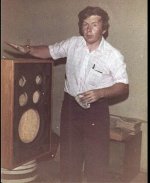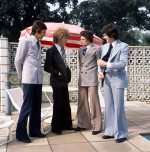Well damn, looks like I'll be ordering a bucket of Decidamp! I was put off by the idea of making then cutting constrained layered boards but with the Decidamp you put the boards on after the cabinet is built. I like that.
You can do that if you add the panels to the inside and clamp them securely while they cure.
You can also build the panels in advance then assemble your cabinet... you just have to make an edge allowance so they don't interfere with the outer casing.
I was thinking making the entire cab out of it. Its a rigid dense and heavy "board". There may be an issue with its structural properties, im not sure. It may "flow" over time and strain??
Maybe will need some structure in the form of braces inside made of wood?
Not sure what to do BUT it is much better damped than any wood and would love to see what can be done with it.
You might find this thread useful:
EVA foam for performance speaker enclosures
I wonder if there is anything I can use that I can pick up at the hardware store. Silicone? Elastomeric caulk?
When I did this on my cabinets, the Decidamp wasn't available (not invented yet) so I did the constraining layer with primer on the wood and silicon caulking compound which seemed to work well enough.
I just built 48x14x11" enclosures out of 3/4 MDF for my TangBand W8-2145 full range speakers. LOTS of screws and adhesive, but no bracing otherwise. The results have been incredible. Huge punchy and wide bass with all the great mid and highs to go with it. I was worried about bracing, but in this experiment, just didn't seem necessary. MDF is a nightmare tho. The dust is horrid, very heavy and frankly difficult to work with. That said, I've never had luck with ply cabs. YMMV.
MDF dust messes with my lungs for days afterward, unless I take steps to prevent it.The dust is horrid,
MDF dust may be cancerous so that should be a consideration. Cheap plywood from Home Depot may cause some resonance at the upper midrange but can be managed with proper bracing. The most practical solution probably gluing together different types of board into about 1in. thick or more for the front baffle and probably 3/4in. for the side and rear panels.
A plywood panel will have some natural resonance at some discrete frequencies if not well treated. Ultimately, you want to distribute the energy evenly to a broad band of frequencies and NOT concentrate to a few discrete frequency bands. There are different solutions but at the end, that's what you want to do.
A plywood panel will have some natural resonance at some discrete frequencies if not well treated. Ultimately, you want to distribute the energy evenly to a broad band of frequencies and NOT concentrate to a few discrete frequency bands. There are different solutions but at the end, that's what you want to do.
Don't forget that when they show transient response, this doesn't do much to highlight poor performance under continuous stimulus. The walls could buckle at lower frequency input, but may only ring at a higher frequency. The amount too.
Certainly not a full indepth study but a very good indication of comparison to non-CLD effects.
You can do that if you add the panels to the inside and clamp them securely while they cure.
You can also build the panels in advance then assemble your cabinet... you just have to make an edge allowance so they don't interfere with the outer casing.
Yep, either way will work. I just wanted to avoid making sheets of CLD sheets than have to cut it.
MDF dust messes with my lungs for days afterward, unless I take steps to prevent it.
Me too Allen. I have a very powerful dust collection system and a professional breather but still that crap shows up for months anyway.
MDF dust may be cancerous so that should be a consideration. Cheap plywood from Home Depot may cause some resonance at the upper midrange but can be managed with proper bracing. The most practical solution probably gluing together different types of board into about 1in. thick or more for the front baffle and probably 3/4in. for the side and rear panels.
I decided last night, after reading through all these great comments, to use good 1/2" plywood, a layer of Decidamp, then another sheet of 1/2" plywood.
So 1" of CLD plywood in the end. Don't know about bracing yet. I have to think on that more.
I decided last night, after reading through all these great comments, to use good 1/2" plywood, a layer of Decidamp, then another sheet of 1/2" plywood.
So 1" of CLD plywood in the end. Don't know about bracing yet. I have to think on that more.
Good idea. In Spain it is difficult to find quality plywood for speakers, because here wood is hardly used for construction.
Front, always 1".
If the woofer, or subwoofer, is big, then you can add a table inside.
Humble Homemade Hifi - Twenty Five
Humble Homemade Hifi - Twenty Five
An externally hosted image should be here but it was not working when we last tested it.
An externally hosted image should be here but it was not working when we last tested it.
Or, as Tony Gee, you can build ALL with 1" plywood with woofer reinforments. And the internal walls put viscoelastic, in addition to between the front and the reinforcement. Less work.
[PDF] http://www.humblehomemadehifi.com/download/Humble%20Homemade%20Hifi_Calpamos.pdf
[PDF] http://www.humblehomemadehifi.com/download/Humble%20Homemade%20Hifi_Calpamos.pdf
An externally hosted image should be here but it was not working when we last tested it.
The inside of the cabinet is lined with 4mm thick bituminous vibration damping panels. Due to the high weight of these panels (and therefore high shipping-costs), they are not included as part of the standard kit but can be supplied if they are not available whereyou live. I used Standartplast STP Aero Bomb but other products such as CTK Vibrodamping, Silent Coat Vibrodamping or DynamatXtreme are equally effective. Apply the damping panels to all internal surfaces except the baffle. It doesn't matter if a few centimeters along the edges of each surface are not covered. The damping panels are self adhesive but I would advise to take extra measures to make sure they stay stuck in place for years to come. First of all, the inside surfaces of the cabinets must bedust and grease free. Then the panels can either be glued using vinyl glue as well as their own adhesive layer. Or you can stickthe panels as they are and then staple them to the cabinets for extra strenght. I chose to do the latter with the help of an electric staple gun.
The soft damping material used in the Calpamos consists of 50mm thick, black polyester fibre acoustic damping sheets. Each sheet is 1000 x 1200mm in size and one whole sheet is needed per loudspeaker cabinet. The damping material covers all internal area's except for the lower part of the side walls near the woofer and also the bottom surface is left free from this soft damping material.
Last edited:
So much "overthinking" to make a stable enclosure!
In that case, virtually all the factory manufactured enclosures in the world, including "high end", are loaded with imperfections.
Short answer: Yes they are.
The designers may crank out a near perfect driver/cabinet/crossover combination but then the needs of manufacturing take over. Assembly order dictates changes in wiring, machining and fastening. Available parts lead to compromises in crossover construction, ports and drivers. Costs play into choices about materials and fasteners.
In the end, virtually everything where more than one is built has compromises.
I decided last night, after reading through all these great comments, to use good 1/2" plywood, a layer of Decidamp, then another sheet of 1/2" plywood.
So 1" of CLD plywood in the end. Don't know about bracing yet. I have to think on that more.
It might not make much difference but an inner layer of MDF which is much more structurally bonded than plywood makes more sense to me. I know the stuff is a real bear to work with but in the long run it might be better.
The thumbnail is me putting finishing touches on my boxes from 1979... I apologize for the image quality but it's the sole remaining picture of that build. If you look closely you can see the layered construction. That was a sealed box, very air tight, with a 12 inch woofer, 2 x 4 inch mids and 2 x 1" dome tweeters, a 3 way 2nd order crossover, all Phillips Deforest line products.
Attachments
Last edited:
MDF dust may be cancerous so that should be a consideration.
Can you provide a link to a real research paper demonstrating this? I do realize you included "may" and I can find this claim easily on the internet but only on forums with the same amount of scientific basis as diyaudio.
Similarly, when I googled about MDF, I found "Wood dust, especially from hardwood, causes nasal and sinus cancer in woodworkers. Some of the species known to cause cancer include the hardwoods oak, mahogany, beech, walnut, birch, elm and ash. As with formaldehyde, these cancers take years to develop and generally require significant, ongoing exposure for a long period of time."
I have a dust collector and wear a mask using MDF or wood.
Those speakers must have furnished some flare flapping moments Douglas!The thumbnail is me putting finishing touches on my boxes from 1979...
Attachments
I've found this Finnish research paper published online in 2012:Can you provide a link to a real research paper demonstrating this?
Occupational exposure to wood dust and formaldehyde and risk of nasal, nasopharyngeal, and lung cancer among Finnish men
"The authors conclude that occupational exposure to wood dust appears to elevate the risk of nasal cancer but not of nasopharyngeal or lung cancer. Formaldehyde does not appear to increase risk in any way whatsoever."
I have been looking at prices for those viscoelastic products and they are very expensive, like years ago.
Luckily I thought about going to a construction warehouse chain. Isolana, with a near shop in Tarragona province (La Canonja).
[Spanish, PDF] https://isolana.es/es/documentacion/tarifa2018/aislamientos-2018.pdf
[Spanish, PDF] https://isolana.es/es/documentacion/tarifa2019/Generica/2.0/TarifaGenerica2019.pdf
TECSOUND(R) SY
[English, PDF] http://www.texsa.com/pdfproducto/en/pl39/productos/id63/tecsound-sy.pdf
I have a Big roll of Tecsound SY 70.
Luckily I thought about going to a construction warehouse chain. Isolana, with a near shop in Tarragona province (La Canonja).
[Spanish, PDF] https://isolana.es/es/documentacion/tarifa2018/aislamientos-2018.pdf
[Spanish, PDF] https://isolana.es/es/documentacion/tarifa2019/Generica/2.0/TarifaGenerica2019.pdf
TECSOUND(R) SY
[English, PDF] http://www.texsa.com/pdfproducto/en/pl39/productos/id63/tecsound-sy.pdf
I have a Big roll of Tecsound SY 70.
Last edited:
- Status
- This old topic is closed. If you want to reopen this topic, contact a moderator using the "Report Post" button.
- Home
- Loudspeakers
- Multi-Way
- Is MDF or plywood better for speaker cabinets?

